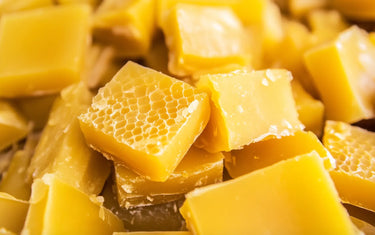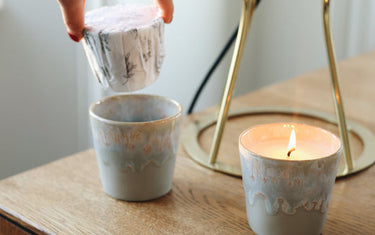7 min read / 2 March 2023 / Laura Garvin Gomez
Vitamin E Oil Benefits for Skin and How to Use It
Topical application of this much-needed vitamin can leave your skin looking revived. Find out why.

We're constantly told about the importance of vitamins and minerals in our diet.
Vitamins can do a lot for us - from keeping our immune systems in check to maintaining strong hair and nails.
Keeping up a healthy lifestyle with plenty of nutrient-dense foods can help achieve the optimal levels we need, and many people opt for the use of supplements as an extra assurance too.
While most of us see supplements as something taken in pill form, the recent popularity of plant-based carrier oils has seen a spike in topical access to these vitamins as well.
Vitamin E is the most popular of these topical oils, with skincare applications dating back decades - across numerous cosmetic and dermatological products.
Implementing a few drops into your skincare, therefore, may sprout a revolutionary change.
Top 5 Main Benefits of Vitamin E Oil for Skin
Vitamin E oil has several potential benefits for your skin, including:
- Moisturising: Vitamin E oil can help moisturise the skin, especially for those with dry or flaky skin.
- Treating skin conditions: Vitamin E oil can help treat skin conditions like eczema and psoriasis.
- Reducing hyperpigmentation: Vitamin E oil can help reduce the appearance of dark spots and hyperpigmentation.
- Treating chapped lips: Vitamin E oil can help relieve chapped lips by promoting cell turnover and regeneration.
- Preventing ageing: Vitamin E oil contains antioxidants that can help improve blood circulation and slow down the ageing process.
What is Vitamin E oil?Vitamin E oil is commonly derived from the leaves of the Triticum Vulgare plant - a type of wheat that is associated with substantial nutrient levels. This oil is sometimes referred to as "wheat germ oil". Many nuts, seeds, and green vegetables are also great sources of vitamin E, which is why it's not unusual to see oils like jojoba or avocado with high levels of the vitamin too. While finding vitamin E in its purest form (known as tocopheryl acetate) can be very expensive, these plant-based oils have been utilised for years as great alternatives thanks to their naturally rich supply. Vitamin E is important to keep on top of as it isn't stored in the body for future use. This means that it's very easy for our vitamin E levels to become low. To avoid this, many people use supplements like oils to help maintain their healthy levels. |
Is vitamin E oil good for your face?
The popularity of vitamin E in cosmetics sprouts from its extremely high antioxidant supply. Antioxidants are crucial for protecting our skin from natural irritants like pollutants, sun exposure, and free radical damage.
Daily use can also positively impact our immune system, with scientists beginning to make links between antioxidants and the fighting of cancer, age-related sight loss, and even Alzheimer's disease.

What are the benefits of vitamin E oil for skin?
We've detailed some of the most impactful vitamin E oil benefits for skin below.
1. It can tackle dry skin
Vitamin E oil is an incredibly effective hydrator, holding moisture in the skin for up to 16 hours without the need for reapplication.
It is also naturally anti-inflammatory, which has led to its popularity among sufferers of dry skin conditions like psoriasis and eczema. These properties can help soothe irritated skin and itching as well as keep the areas hydrated.
In fact, the effects of vitamin E against dry skin are so strong that a study from 2015 deemed it a sure-fire treatment against atopic dermatitis. [1]
2. It can protect against sun damage
According to a 2016 review, vitamin E oil is said to have incredibly potent photoprotective effects. [2]
This means that the oil can successfully safeguard the body from molecular damage caused by sunlight.
Research performed on mice further noted that those using vitamin E supplements were less likely to develop skin cancer as a result of UV ray exposure, however this is yet to be confirmed on humans.
Vitamin E oil is also a popular household remedy for sunburn, thanks to its anti-inflammatory benefits which can help reduce the pain and redness.
3. It can help maintain youthful-looking skin
The high antioxidant levels found in vitamin E can help improve blood circulation around the face, leading to to a fuller and more youthful complexion.
Antioxidants can also keep lipid levels high and fresh, reducing signs of wrinkles over time by helping to maintain the skin's protective barrier.
4. It reduces hyperpigmentation and scarring
Also known as melasma, hyperpigmentation refers to the increased production of melanin in certain areas of the skin. This can lead to dark spots, which is a common side effect of aging as well as high levels of sun exposure.
Some researchers suggest that combining vitamin E oil with vitamin C can help reduce hyperpigmentation, dark circles, and scarring caused by facial acne.
5. It removes dirt
Vitamin E oil is an emollient, which is essentially another word for a deeply cleansing moisturiser.
Its emollient properties can work beneath the skin barrier to remove dirt from your pores and give skin a smooth, refreshed appearance.

How to use Vitamin E oil for face
Adding vitamin E oil to your routine is very simple. You can gently massage the oil into your skin and leave it on overnight for the best results.
Or alternatively, if you want to add it into your daily routine with minimal effort, you could add some vitamin e oil into your face masks or creams.
Like most plant-based carrier oils, vitamin E doesn't require any sort of dilution before application, so you can use it straight from the bottle whenever you feel you need it most.
For the best results, we recommend following these steps:
- Wash your face with warm water to open up your pores. This will help the effects of the Vitamin E oil go further. Pat dry with a clean towel.
- To help your pores open up even more, try wrapping a warm towel across your face for a few minutes before application.
- Dispense a pea-sized amount of oil onto your hand and gently rub into your face.
- Leave on for 15 minutes over overnight if your skin is particularly dry.
- Wash off as normal with lukewarm water.
If you prefer, you can also try combining your vitamin E oil with other carrier oils like coconut or jojoba to help make it a little easier (and more gentle - so you can leave it on for longer) to apply.
This is an especially good idea if you plan on adding essential oils to your natural face-cleansing routine, as some oils require longer than 15 minutes to achieve their desired effects.
Are there any precautions for using vitamin E oil?
Despite its nourishing benefits, vitamin E oil may not always be the best fit for all skin types.
If you have oily or acne-prone skin, it's advised not to leave the oil on your face for more than 15 minutes. Vitamin E oil is very thick and can easily clog the pores if left on for too long.
Similarly, if you have sensitive skin, you should avoid use over the 15 minute mark as any longer could lead to irritation.
In any case, you should always perform a patch test before applying vitamin E oil to your skin. Vitamin E is often associated with allergic reactions and therefore proper precautions should always be taken before use.
If you notice itchiness, redness, or the formations of a rash, cease use immediately.
It's also not uncommon for vitamin E oil to stain clothes and furnishings. If you choose to apply to oil anywhere else on your body, take care to ensure it's fully rinsed off before changing.
Frequently Asked QuestionsWhen should I apply vitamin E oil on the skin?The best time to apply vitamin E oil is in the evening. Vitamin E has a thicker texture that may make it more difficult to apply cosmetics, so night time application is generally preferred to help avoid this. Can I leave vitamin E oil on skin overnight?If you have dry skin, keeping vitamin E oil on your face overnight is considered the most effective method, however this is not advised for other skin types. If you do choose to leave the oil on overnight, be sure to cover your pillow with an old t-shirt or towel to avoid stains on your bedding. Can I use other oils alongside vitamin E?For oily and sensitive skin types, it's recommended to combine vitamin E oil with another skin-loving carrier oil like jojoba or coconut. This can help reduce the potent effects and can allow you to keep the oil on your face for much longer periods. You can also try using vitamin E to dilute any essential oils you'd like to use. Is vitamin E oil good for stretch marks?Some sources claim that the topical application of vitamin E can manage the appearance of stretch marks by keeping the skin flexible and hydrated. This is particularly the case during pregnancy, but you should always check with your doctor before using any natural remedies on your skin. |

While vitamin E may not be the most flexible carrier oil in the world, it's certainly worth the time and consideration.
Vitamin E is majorly important for our bodies and can work wonders on our skin with the right attitude and with consistent application.
Remember to always perform a patch test if you're a first-time user of the oil, and to make sure you're leaving it on for the appropriate amount of time depending on your skin type.
Most of all, enjoy the benefits! Your complexion will thank you greatly for the extra love and protection.
References
[1] Fariba Jaffary et al. (2015) Effects of oral vitamin E on treatment of atopic dermatitis: A randomized controlled trial https://www.ncbi.nlm.nih.gov/pmc/articles/PMC4755091/
[2] Mohammad Abid Keen et al. (2016) Vitamin E in dermatology https://www.ncbi.nlm.nih.gov/pmc/articles/PMC4976416/










